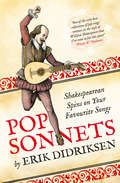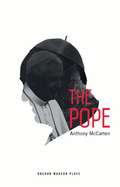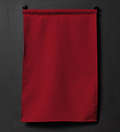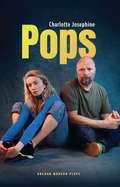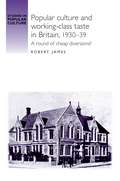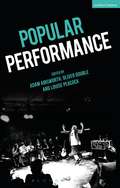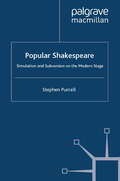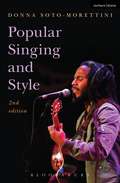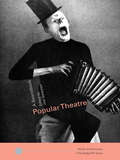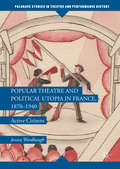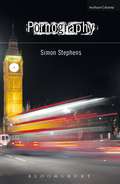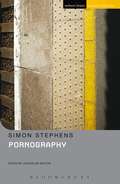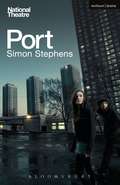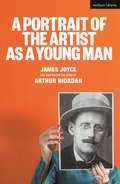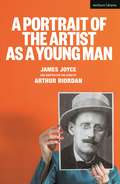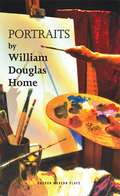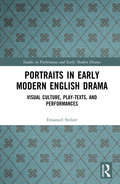- Table View
- List View
Pop Sonnets: Shakespearean Spins On Your Favorite Songs
by Erik Didriksen‘One of the very best collections of pop songs written in the style of William Shakespeare that I’ve read so far this year!’ ‘Weird Al’ Yankovic ‘Ever wonder what Taylor Swift and Beyoncé would sound like in iambic pentameter? We hadn’t either, but now we can’t get enough’ TIME ‘Amazing’ Buzzfeed
The Pope: Francis, Benedict, And The Decision That Changed The World (Oberon Modern Plays)
by Anthony McCartenSix years ago Pope Benedict XVI stunned the world by resigning, the first Pope in 700 years to do so. What drove this arch-conservative to break with sacred tradition and cede the way for Cardinal Bergoglio – a one-time tango club bouncer, football-loving reformer with the common touch – to become Pope Francis, one of most powerful men on earth? In this fascinating, gripping and often funny story of two very different men, Pope Benedict and Cardinal Bergoglio grapple with their complex pasts and uncertain futures. From coming of age under dictatorships in Germany and Argentina, to the scandal of sexual abuse by the clergy, The Pope shines a light onto one of the world’s most secretive institutions. At its heart lies a timeless question: in moments of crisis, should we follow the rules or our conscience?
Pope.L: Showing Up to Withhold
by The Renaissance Society at the University of ChicagoIconoclast and artist Pope.L uses the body, sex, and race as his materials the way other artists might use paint, clay, or bronze. His work problematizes social categories by exploring how difference is marked economically, socially, and politically. Working in a range of media from ketchup to baloney to correction fluid, with a special emphasis on performativity and writing, Pope.L pokes fun at and interrogates American society’s pretenses, the bankruptcy of contemporary mores, and the resulting repercussions for a civil society. Other favorite Pope.L targets are squeamishness about the human body and the very possibility of making meaning through art and its display. Published to accompany his wonderfully inscrutable exhibition Forlesen at the Renaissance Society at the University of Chicago, Pope.L: Showing Up to Withhold is simultaneously an artist’s book and a monograph. In addition to reproductions of a number of his most recent artworks, it includes images of significant works from the past decade, and presents a forum for reflection and analysis on art making today with contributions by renowned critics and scholars, including Lawrie Balfour, Nick Bastis, Lauren Berlant, and K. Silem Mohammad.
Pope.L: Showing Up to Withhold
by The Renaissance Society at the University of ChicagoIconoclast and artist Pope.L uses the body, sex, and race as his materials the way other artists might use paint, clay, or bronze. His work problematizes social categories by exploring how difference is marked economically, socially, and politically. Working in a range of media from ketchup to baloney to correction fluid, with a special emphasis on performativity and writing, Pope.L pokes fun at and interrogates American society’s pretenses, the bankruptcy of contemporary mores, and the resulting repercussions for a civil society. Other favorite Pope.L targets are squeamishness about the human body and the very possibility of making meaning through art and its display. Published to accompany his wonderfully inscrutable exhibition Forlesen at the Renaissance Society at the University of Chicago, Pope.L: Showing Up to Withhold is simultaneously an artist’s book and a monograph. In addition to reproductions of a number of his most recent artworks, it includes images of significant works from the past decade, and presents a forum for reflection and analysis on art making today with contributions by renowned critics and scholars, including Lawrie Balfour, Nick Bastis, Lauren Berlant, and K. Silem Mohammad.
Pops (Oberon Modern Plays)
by Charlotte JosephineThey’re trying. Despite everything. They’re really trying. They almost work together, beautifully. Looking at what is inherited and who is responsible, award-winning writer Charlotte Josephine’s new play Pops follows a father and daughter caught in a vicious cycle of addiction, and the self-inflicted shame around mental health.
Popular culture and working–class taste in Britain, 1930–39: A round of cheap diversions? (PDF) (Studies in Popular Culture)
by Robert JamesThis book examines the relationship between class and culture in 1930s Britain. Focusing on the reading and cinema-going tastes of the working classes, Robert James’ landmark study combines rigorous historical analysis with a close textual reading of visual and written sources to appraise the role of popular leisure in this fascinating decade. Drawing on a wealth of original research, this lively and accessible book adds immeasurably to our knowledge of working-class leisure pursuits in this contentious period. It is a key intervention in the field, providing both an imaginative approach to the subject and an abundance of new material to analyse, thus making it an undergraduate and postgraduate ‘must-have’. It will be a particularly welcome addition for anyone interested in the fields of cultural and social history, as well as film, cultural and literary studies.
Popular culture and working–class taste in Britain, 1930–39: A round of cheap diversions? (Studies in Popular Culture)
by Robert JamesThis book examines the relationship between class and culture in 1930s Britain. Focusing on the reading and cinema-going tastes of the working classes, Robert James’ landmark study combines rigorous historical analysis with a close textual reading of visual and written sources to appraise the role of popular leisure in this fascinating decade. Drawing on a wealth of original research, this lively and accessible book adds immeasurably to our knowledge of working-class leisure pursuits in this contentious period. It is a key intervention in the field, providing both an imaginative approach to the subject and an abundance of new material to analyse, thus making it an undergraduate and postgraduate ‘must-have’. It will be a particularly welcome addition for anyone interested in the fields of cultural and social history, as well as film, cultural and literary studies.
Popular Performance
by Adam Ainsworth Oliver Double Louise PeacockThere is no fourth wall in popular performance. The show is firmly rooted in the here and now, and the performers address the audience directly, while the audience answer back with laughter, applause or heckling. Performer and role are interlaced, so that we are left uncertain about just how the persona we see onstage might relate to the private person who presents it to us. Popular Performance defines and surveys varieties of performance where the main purpose is to entertain, and where there is no shame in being trivial, frivolous or nonsensical as long as people go home happy at the end of the show. Contributions by new and established scholars focus particularly on how it is made, explaining the techniques of performance and production that make it so appealing to audiences. With sections examining how popular performance works in a range of historical and contemporary examples, readers will gain insights into:* performance forms associated with the variety tradition: music hall, vaudeville, cabaret, variety* performance forms associated with circus: wild west shows, clowning* issues relating to the identity of the performer in relation to magic, burlesque, pantomime in contemporary performance* issues relating to venue and audience in relation to contemporary street theatre, stand-up, and live sketch comedy.
Popular Performance
by Adam Ainsworth Oliver Double Louise PeacockThere is no fourth wall in popular performance. The show is firmly rooted in the here and now, and the performers address the audience directly, while the audience answer back with laughter, applause or heckling. Performer and role are interlaced, so that we are left uncertain about just how the persona we see onstage might relate to the private person who presents it to us. Popular Performance defines and surveys varieties of performance where the main purpose is to entertain, and where there is no shame in being trivial, frivolous or nonsensical as long as people go home happy at the end of the show. Contributions by new and established scholars focus particularly on how it is made, explaining the techniques of performance and production that make it so appealing to audiences. With sections examining how popular performance works in a range of historical and contemporary examples, readers will gain insights into:* performance forms associated with the variety tradition: music hall, vaudeville, cabaret, variety* performance forms associated with circus: wild west shows, clowning* issues relating to the identity of the performer in relation to magic, burlesque, pantomime in contemporary performance* issues relating to venue and audience in relation to contemporary street theatre, stand-up, and live sketch comedy.
Popular Shakespeare: Simulation and Subversion on the Modern Stage (Palgrave Shakespeare Studies)
by S. PurcellIn recent years, the 'Popular Shakespeare' phenomenon has become ever more pervasive: in fringe productions, mainstream theatre, or the mass media, Shakespeare is increasingly constructed as an authentic part of popular culture. A vivid account of Shakespeare in performance since the 1990s, this book examines what 'Shakespeare' means to us today.
Popular Singing and Style: 2nd edition (Performance Books)
by Donna Soto-MorettiniThis second edition of the highly successful Popular Singing serves as a practical guide to exploring the singing voice while helping to enhance vocal confidence in a range of popular styles. The book provides effective alternatives to traditional voice training methods, and demonstrates how these methods can be used to create a flexible and unique sound.This updated and thoroughly revised edition features a new chapter on training for popular singing, which incorporates recent movements in teaching the discipline across the globe, taking into account recent developments in the area. The book also features a new section on 'bridging' - ie. using all the technical elements outlined in the book to help the singer find their own particular expressive style to inspire more playfulness and creativity, both for the individual singer and for the teacher in practice and performance.
Popular Singing and Style: 2nd edition (Performance Books)
by Donna Soto-MorettiniThis second edition of the highly successful Popular Singing serves as a practical guide to exploring the singing voice while helping to enhance vocal confidence in a range of popular styles. The book provides effective alternatives to traditional voice training methods, and demonstrates how these methods can be used to create a flexible and unique sound.This updated and thoroughly revised edition features a new chapter on training for popular singing, which incorporates recent movements in teaching the discipline across the globe, taking into account recent developments in the area. The book also features a new section on 'bridging' - ie. using all the technical elements outlined in the book to help the singer find their own particular expressive style to inspire more playfulness and creativity, both for the individual singer and for the teacher in practice and performance.
Popular Theatre: A Sourcebook (Worlds of Performance)
by Joel SchechterBertolt Brecht turned to cabaret; Ariane Mnouchkine went to the circus; Joan Littlewood wanted to open a palace of fun. These were a few of the directors who turned to popular theatre forms in the last century, and this sourcebook accounts for their attraction.Popular theatre forms introduced in this sourcebook include cabaret, circus, puppetry, vaudeville, Indian jatra, political satire, and physical comedy. These entertainments are highly visual, itinerant, and readily understood by audiences. Popular Theatre: A Sourcebook follows them around the world, from the bunraku puppetry of Japan to the masked topeng theatre of Bali to South African political satire, the San Francisco Mime Troupe's comic melodramas, and a 'Fun Palace' proposed for London.The book features essays from the archives of The Drama Review and other research. Contributions by Roland Barthes, Hovey Burgess, Marvin Carlson, John Emigh, Dario Fo, Ron Jenkins, Joan Littlewood, Brooks McNamara, Richard Schechner, and others, offer some of the most important, informative, and lively writing available on popular theatre. Introducing both Western and non-Western popular theatre practices, the sourcebook provides access to theatrical forms which have delighted audiences and attracted stage artists around the world.
Popular Theatre: A Sourcebook (Worlds of Performance)
by Joel SchechterBertolt Brecht turned to cabaret; Ariane Mnouchkine went to the circus; Joan Littlewood wanted to open a palace of fun. These were a few of the directors who turned to popular theatre forms in the last century, and this sourcebook accounts for their attraction.Popular theatre forms introduced in this sourcebook include cabaret, circus, puppetry, vaudeville, Indian jatra, political satire, and physical comedy. These entertainments are highly visual, itinerant, and readily understood by audiences. Popular Theatre: A Sourcebook follows them around the world, from the bunraku puppetry of Japan to the masked topeng theatre of Bali to South African political satire, the San Francisco Mime Troupe's comic melodramas, and a 'Fun Palace' proposed for London.The book features essays from the archives of The Drama Review and other research. Contributions by Roland Barthes, Hovey Burgess, Marvin Carlson, John Emigh, Dario Fo, Ron Jenkins, Joan Littlewood, Brooks McNamara, Richard Schechner, and others, offer some of the most important, informative, and lively writing available on popular theatre. Introducing both Western and non-Western popular theatre practices, the sourcebook provides access to theatrical forms which have delighted audiences and attracted stage artists around the world.
Popular Theatre and Political Utopia in France, 1870—1940: Active Citizens (Palgrave Studies in Theatre and Performance History)
by Jessica WardhaughThis book is the first study of popular theatre in France from left to right, exploring how theatre shapes political acts, ideals, and communities in the modern world. As the French found innovative ways of imagining culture and politics in the age of the masses, popular theatre became central to the republican project of using art to create citizens, using secular spaces for the experience of civic communion. But while state projects often faltered in finding playwrights, locations, and audiences, popular theatre flourished on the political and geographical peripheries. Drawing on extensive archival research, this book illuminates lost worlds of political conviviality, from anarchist communes and clandestine agit-prop drama to royalist street politics and right-wing mass spectacle. It reveals new connections between French initiatives and their European counterparts, and demonstrates the enduring strength of radical communities in shaping political ideals and engagement.
Pornography (Modern Plays)
by Simon StephensPornography is Simon Stephens' stark and shattering new play that powerfully captures a portrait of a fractured, insecure Britain. Written in reaction to London crashing from the euphoria and promise at being awarded the 2012 Olympics into the chaos and reality of the 7/7 bombings, the play is composed of seven stories that serve as a countdown to the catastrophic attack on London. Each playlet focuses on a different individual dramatising their life in the run-up to the tragedy.Published to coincide with the English language premiere at the Traverse Theatre in August as part of the International Edinburgh Festival before transferring to the Birmingham Rep, this is the first stage play to confront the London bombings of 7 July 2005.
Pornography: One Minute - Country Music - Motortown - Pornography - Sea Wall (Modern Plays)
by Simon StephensPornography is Simon Stephens' stark and shattering new play that powerfully captures a portrait of a fractured, insecure Britain. Written in reaction to London crashing from the euphoria and promise at being awarded the 2012 Olympics into the chaos and reality of the 7/7 bombings, the play is composed of seven stories that serve as a countdown to the catastrophic attack on London. Each playlet focuses on a different individual dramatising their life in the run-up to the tragedy.Published to coincide with the English language premiere at the Traverse Theatre in August as part of the International Edinburgh Festival before transferring to the Birmingham Rep, this is the first stage play to confront the London bombings of 7 July 2005.
Pornography: One Minute - Country Music - Motortown - Pornography - Sea Wall (Student Editions)
by Simon StephensPornography looks at the events of the first week of July 2005 (the G8 summit, Live 8, the announcement of the 2012 Olympics and the 7/7 bombings) through the perspectives of eight anonymous individuals, including a terrorist. The play can be performed by any number of actors with the scenes presented in any order. This flexibility means that it is ideal for student groups: containing four monologues, two duologues and fifty-two self-contained anecdotal speeches.This Student Edition offers a study of the meaning, context and performance choices available in this subtle and political play. The in-depth commentary explores the play's themes, its kaleidoscopic structure and the play's production history, looking at both the German and UK premieres. The editor, Jacqueline Bolton, incorporates previously unpublished interviews with Simon Stephens and the directors and dramaturgs associated with the early productions. The commentary reveals the play's performance possibilities, as well as discussing its accomplished form, innovative structure and compassionate impetus. It also includes a chronology of the playwright's life and work, an introduction giving the background to the play, commentary on themes, characters, language and style, notes on individual words and phrases in the text, questions for further study and bibliography and further reading.
Pornography (Student Editions)
by Simon Stephens Jacqueline BoltonPornography looks at the events of the first week of July 2005 (the G8 summit, Live 8, the announcement of the 2012 Olympics and the 7/7 bombings) through the perspectives of eight anonymous individuals, including a terrorist. The play can be performed by any number of actors with the scenes presented in any order. This flexibility means that it is ideal for student groups: containing four monologues, two duologues and fifty-two self-contained anecdotal speeches.This Student Edition offers a study of the meaning, context and performance choices available in this subtle and political play. The in-depth commentary explores the play's themes, its kaleidoscopic structure and the play's production history, looking at both the German and UK premieres. The editor, Jacqueline Bolton, incorporates previously unpublished interviews with Simon Stephens and the directors and dramaturgs associated with the early productions. The commentary reveals the play's performance possibilities, as well as discussing its accomplished form, innovative structure and compassionate impetus. It also includes a chronology of the playwright's life and work, an introduction giving the background to the play, commentary on themes, characters, language and style, notes on individual words and phrases in the text, questions for further study and bibliography and further reading.
Port (Modern Plays)
by Simon StephensI see you in the morning, on the first morning I stayed over at your house. Waking up. Watching you lying asleep next to me. You looked, you looked. It was like. I think about that more than you probably think I do.Stockport 1988-2002. Racheal Keats is growing up in a town she doesn't like with a family in tatters and a future she cannot picture. As those she loves begin to let her down or leave her behind, can Rachel find the strength to make her own way in the world?Port premiered at the Royal Exchange Theatre, Manchester, in November 2002. It was later staged in the Lyttelton at the National Theatre, opening in January 2013. Both productions were by Marianne Elliott.
Port: Bluebird; Christmas; Herons; Port (Modern Plays)
by Simon StephensI see you in the morning, on the first morning I stayed over at your house. Waking up. Watching you lying asleep next to me. You looked, you looked. It was like. I think about that more than you probably think I do.Stockport 1988-2002. Racheal Keats is growing up in a town she doesn't like with a family in tatters and a future she cannot picture. As those she loves begin to let her down or leave her behind, can Rachel find the strength to make her own way in the world?Port premiered at the Royal Exchange Theatre, Manchester, in November 2002. It was later staged in the Lyttelton at the National Theatre, opening in January 2013. Both productions were by Marianne Elliott.
A Portrait of the Artist as a Young Man (Modern Plays)
by James Joyce Arthur RiordanThe spiritual rebellion of Stephen Dedalus and his restless search for self-expression is brought to life in a thrilling theatrical adaptation by Arthur Riordan. Based upon James Joyce's novel of the same name, A Portrait of the Artist as a Young Man is a reworking of the classic coming-of-age story. Charting Stephen's transformation into a man, we follow him through the major milestones and stumbling blocks of his life: his school days, his first romance, his loss of faith and finally to his initiation into the world of writing. In Arthur Riordan's witty and poignant adaptation of 'Joyce's manifesto', A Portrait of the Artist as a Young Man challenges perceptions of family, homeland, and the Catholic Church. This edition of the adaptation was published to coincide with Rough Magic's world premiere of the production at the Dublin Theatre Festival in autumn 2018.
A Portrait of the Artist as a Young Man (Modern Plays)
by James Joyce Mr Arthur RiordanThe spiritual rebellion of Stephen Dedalus and his restless search for self-expression is brought to life in a thrilling theatrical adaptation by Arthur Riordan. Based upon James Joyce's novel of the same name, A Portrait of the Artist as a Young Man is a reworking of the classic coming-of-age story. Charting Stephen's transformation into a man, we follow him through the major milestones and stumbling blocks of his life: his school days, his first romance, his loss of faith and finally to his initiation into the world of writing. In Arthur Riordan's witty and poignant adaptation of 'Joyce's manifesto', A Portrait of the Artist as a Young Man challenges perceptions of family, homeland, and the Catholic Church. This edition of the adaptation was published to coincide with Rough Magic's world premiere of the production at the Dublin Theatre Festival in autumn 2018.
Portraits (Oberon Modern Plays)
by William Douglas-HomeAugustus John's ability as portrait artist won him the admiration of fellow artists, public recognition and the Order of Merit. William Douglas Home's play presents various points in the Bohemian artist's turbulent life from 1944 – 1961 through a reconstruction of sittings with three of his subjects (all played by the same actor) – General Bernard Montgomery, fellow artist Mathew Smith and designer Cecil Beaton. This keenly observed, sensitive play is finely interwoven with the thread of John's gradually developing pacifism – from his certainty in spring 1944 that Monty's young ADC will not survive the second front, to war's devastating effect on Matthew Smith, to John's vibrant fear of the nuclear nightmare and his own approaching death. The first production of this play in 24 years, Portraits commemorates the 50th anniversary of the death of artist Augustus John.
Portraits in Early Modern English Drama: Visual Culture, Play-Texts, and Performances (Studies in Performance and Early Modern Drama)
by Emanuel StelzerPortraits in Early Modern English Drama studies the complex web of interconnections that grows out of the presentation of portraits as props in early modern English drama. Emanuel Stelzer considers this theory from the Elizabethan age up to the closing of the theatres. This book examines how the dramatic text and the subjectivities of the dramatis personae are shaped and changed through the process of observation and interpretation of pictures in the dramatic actions and dialogues. Unlike any previous study, it confronts when a portrait is clearly meant not to be a miniature. This also has bearings on the effect of the picture on the audience and in terms of genre expectation. Two important questions are interrogated in the book: What were the price and value of these portraits? and What were the strategies deployed by the playing companies to show women’s portraits in a theatre without actresses? This book will be of interest to different areas of research dealing with the history of drama and literature, material and visual culture studies, art history, gender studies, and performance studies.
